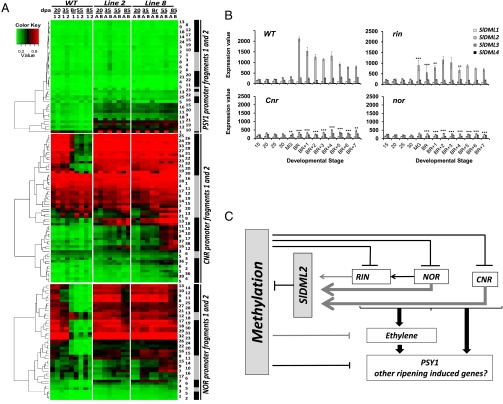Fig. 6.
Bisulfite-sequencing analysis at the NOR, CNR, and PSY1 promoter fragments in WT and transgenic DML RNAi plants. (A) Heat-map representation of DNA methylation at selected NOR, CNR, and PSY1 promoter regions (SI Appendix, Fig. S8) in fruits of control (WT1 and WT2) and transgenic (DML2A, -2B, -8A, and -8B) plants at five (WT and line 8) or four (line 2) developmental stages. For each promoter, two fragments have been analyzed (fragment 1, gray box; fragment 2, black box), the positions of which are shown in SI Appendix, Fig. S8 and Fig. S9. The position of the Cs within each promoter fragment is also shown (number in the columns on the right side), as defined in SI Appendix, Fig. S8. For each promoter, Cs have been clustered considering the two PCR fragments analyzed together. (B) Changes in expression of SlDML genes in fruits of Ailsa Craig (WT) and near-isogenic mutant lines rin, Cnr, and nor, as determined by microarrays analysis. For fruit development, days postanthesis are shown. Mature green is 40 dpa in Ailsa Craig and then Br is 49 dpa. For nonripening mutants, Br onward are 49 dpa + 1–7 d. Asterisks indicate significant difference (variance ratio, F tests) between WT and mutant lines for the SlDML2 gene only to avoid overloading the figure: *P < 0.05; **P < 0.01; ***P < 0.001). Details of expression results and statistical analyses for all four genes are provided in Dataset S1. Error bars indicate means ± SD. (C) Proposed function of DNA demethylation in the control of fruit ripening; SlDML2 is necessary for the active demethylation of the NOR, CNR, RIN, and PSY1 promoter region, thereby allowing these gene expressions. SlDML2 gene expression is reduced in the rin, nor, and Cnr background, suggesting a regulatory loop. There is at this time no evidence of direct regulation of the SlDML2 gene by the RIN, NOR, or CNR protein. SlDML2 may control the expression of additional ripening induced gene, as shown in this study for the PSY1 gene and suggested by the demethylation of several promoters during fruit ripening (20). Arrows indicate activation. Lines indicate repression: black, direct effects; gray, direct or indirect effects.

